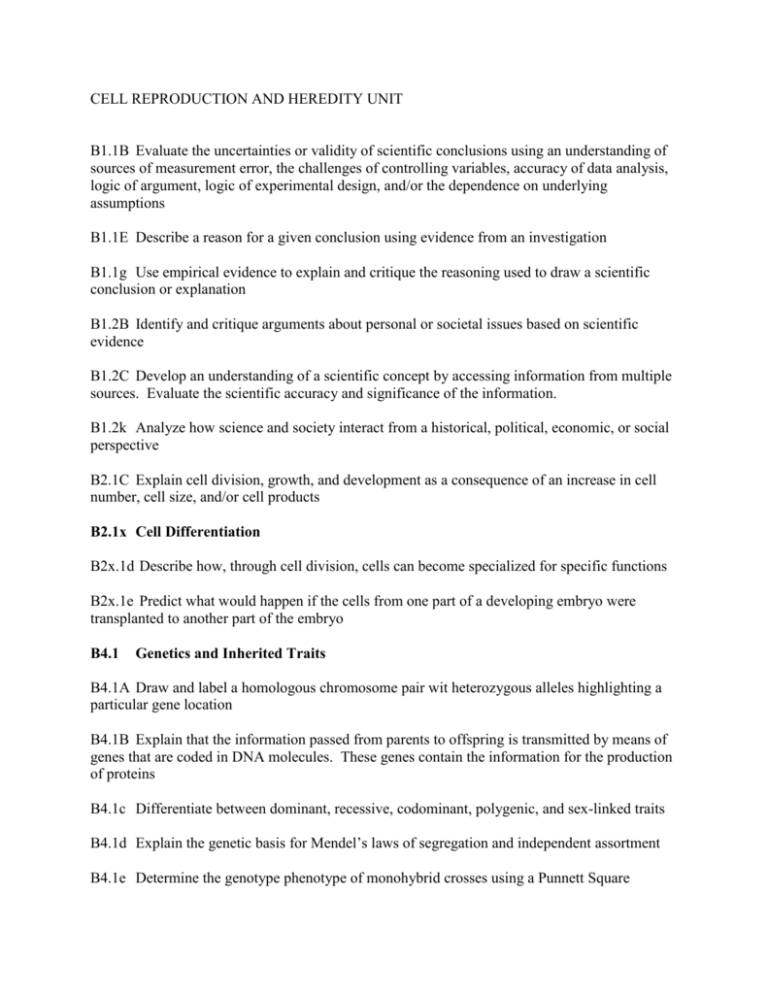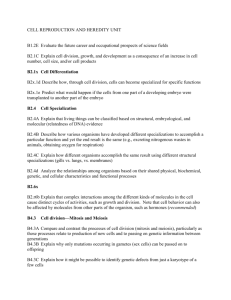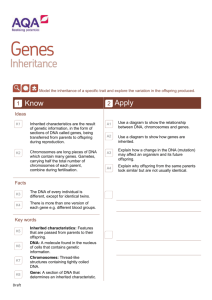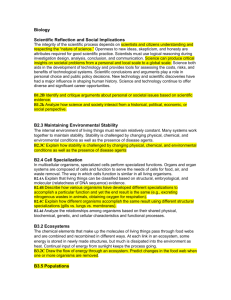CELL REPRODUCTION AND HEREDITY UNIT
advertisement

CELL REPRODUCTION AND HEREDITY UNIT B1.1B Evaluate the uncertainties or validity of scientific conclusions using an understanding of sources of measurement error, the challenges of controlling variables, accuracy of data analysis, logic of argument, logic of experimental design, and/or the dependence on underlying assumptions B1.1E Describe a reason for a given conclusion using evidence from an investigation B1.1g Use empirical evidence to explain and critique the reasoning used to draw a scientific conclusion or explanation B1.2B Identify and critique arguments about personal or societal issues based on scientific evidence B1.2C Develop an understanding of a scientific concept by accessing information from multiple sources. Evaluate the scientific accuracy and significance of the information. B1.2k Analyze how science and society interact from a historical, political, economic, or social perspective B2.1C Explain cell division, growth, and development as a consequence of an increase in cell number, cell size, and/or cell products B2.1x Cell Differentiation B2x.1d Describe how, through cell division, cells can become specialized for specific functions B2x.1e Predict what would happen if the cells from one part of a developing embryo were transplanted to another part of the embryo B4.1 Genetics and Inherited Traits B4.1A Draw and label a homologous chromosome pair wit heterozygous alleles highlighting a particular gene location B4.1B Explain that the information passed from parents to offspring is transmitted by means of genes that are coded in DNA molecules. These genes contain the information for the production of proteins B4.1c Differentiate between dominant, recessive, codominant, polygenic, and sex-linked traits B4.1d Explain the genetic basis for Mendel’s laws of segregation and independent assortment B4.1e Determine the genotype phenotype of monohybrid crosses using a Punnett Square B4.2 DNA B4.2A Show that when mutations occur in sex cells, they can be passed on to offspring (inherited mutations), but if they occur in other cells, they can be passed on to descendent cells only (noninherited mutations) B4.2B Recognize that every species has its own characteristic DNA sequence B4.2C Describe the structure and function of DNA. B4.2D Predict the consequences that changes in the DNA composition of particular genes may have on an organism (e.g., sickle cell anemia, other) B4.2E Propose possible effects (on the genes) of exposing an organism to radiation and toxic chemicals B4.2x DNA, RNA, and Protein Synthesis B4.2f Demonstrate how the genetic information in DNA molecules provides instructions for assembling protein molecules and that this is virtually the same mechanism for all life forms B4.2g Describe the processes of replication, transcription, and translation and how they relate to each other in molecular biology B4.2h Recognize that genetic engineering techniques provide great potential and responsibilities B4.r2i Explain how recombinant DNA technology allows scientists to analyze the structure and function of genes (recommended) B4.3 Cell division—Mitosis and Meiosis B4.3A Compare and contrast the processes of cell division (mitosis and meiosis), particularly as those processes relate to production of new cells and to passing on genetic information between generations B4.3B Explain why only mutations occurring in gametes (sex cells) can be passed on to offspring B4.3C Explain how it might be possible to identify genetic defects from just a karyotype of a few cells B4.3d Explain that the sorting and recombination of genes in sexual reproduction result in a great variety of possible gene combinations from the offspring of two parents B4.3e Recognize that genetic variation can occur from such processes as crossing over, jumping genes, deletion and duplication of genes B4.3f Predict how mutations may be transferred to progeny B4.3g Explain that cellular differentiation results from gene expression and/or environmental influence (e.g., metamorphosis, nutrition) B4.4x Genetic variation B4.4a Describe how inserting deleting, or substituting DNA segments can alter a gene. Recognize that an altered gene may be passed on to every cell that develops from it and that the resulting features may help, harm, or have little or no effect on the offspring’s success in its environment B4.4b Explain that gene mutation in a cell can result in uncontrolled cell division called cancer. Also know that exposure of cells to certain chemicals and radiation increases mutations and thus increases the chance of cancer B4.4c Explain how mutations in the DNA sequence of a gene may be silent or result in phenotypic change in an organism and in its offspring B4.r5x Recombinant DNA B4.r5a Explain how recombinant DNA technology allows scientists to analyze the structure and function of genes (recommended) B4.r5b Evaluate the advantages and disadvantages of human manipulation of DNA (recommended)









